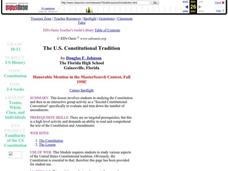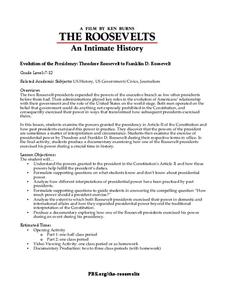Center for Civic Education
Historical Analysis of Constitutional Amendments
Each of the 27 Amendments to the U.S. Constitution were adopted within specific economic, political, social or cultural, and international contexts. As part of their Constitution Day/Week studies, seniors investigate these factors for...
Curated OER
Creating a Classroom Constitution
Youngsters identify and interpret the importance of having rules in order to maintain order at home, at school, in their community, and in the United States. They create a working Classroom Constitution that governs the classroom and...
Hyperion Publishing
Words We Live By: Your Annotated Guide to the Constitution
The language of the Constitution can feel quite ominous to young learners, but there are a variety of strategies you can utilize to help your class grasp the important concepts and ideals in our nation's founding document. This lesson...
C-SPAN
The Electoral College and the Constitution
What is the purpose of the Electoral College? Is it antiquated, or does it have a place in today's political climate? High schoolers view a series of video clips as they analyze the parts of the United States Constitution that address...
Curated OER
Philadelphia and the Constitutional Convention "Heat Up"
Young scholars explore the Constitutional Convention of 1787. In this U.S. Constitution lesson, students role play the parts of delegates in a simulation of the convention.
Curated OER
The U.S. Constitutional Tradition
Learners study the Constitution and then in an interactive group activity create a "Second Constitutional Convention" specifically designed to evaluate and trim down the number of amendments.
Curated OER
The Happy Progress of Our Affairs: George Washington and the U.S. Constitution
High schoolers engage in a lesson which uses Washington's own words to illustrate the events leading to the establishment of our national government, and the crucial roles he played throughout that process.
Curated OER
Interview With the Signers of the Constitution
Students work in small groups to develop three questions that a newspaper reporter assigned to cover the signing of the Constitution might have asked each of the following signers of the Constitution: George Washington, Benjamin...
PBS
Evolution of the Presidency: Theodore Roosevelt to Franklin D. Roosevelt
How much power should a president be allowed to exert? Theodore Roosevelt and Franklin D. Roosevelt exercised their power according to their interpretations of the United States Constitution, and these interpretations affected the...
Curated OER
Searching for Answers
How does a judge in the federal judicial court decide on a verdict? Give your middle and high schoolers a better idea of how final decisions are made in the judicial system. Then split your class into four groups, assigning each group a...
Curated OER
Presidential Powers
Students study and discuss the section of the Constitution that refers to the executive branch. They write a new section or clause describing a new duty for the president of the United States. Students define the word power and proposal.
Project Tahoe
Does the Use of Torture on Enemy Combatants Violate the 8th Amendment?
Tackle ethics in your high school history classes with a Socratic seminar about torture as a means for obtaining information. The plan allows for pupils to take the reins during the seminar. On the first day, class members read several...
Curated OER
The Constitution Lives! How it Protects Your Rights Today
Students brainstorm their rights as Americans. In this The Constitution Lives! instructional activity, students discern the difference between rights and rules by completing a worksheet. Students consider the differences between types of...
Curated OER
Constitution Day
Students discuss the need for rules in their community and classroom. Using this information, they identify the authority figures at their house, at school and in the community. They are read a book about following the rules and listen...
Curated OER
Covenants, Compacts, Constitutions and By-Laws... Written Documents that Guide Governing
Third graders discuss documents in our government. In this government lesson, 3rd graders look up vocabulary words and illustrate them. They examine a historical document to discuss and answer questions.
Curated OER
Teaching with Poster Art: World War I Posters
Students interpret historical evidence presented in primary resources. In this World War I lesson, students examine World War I posters. Students investigate the use of propaganda strategies in the posters and discuss the visual metaphors.
Curated OER
D-day Message from General Eisenhower to General Marshall
Students analyze a "top secret" document written by Eisenhower. They identify and chart cliches for those about to go into battle and read related poetry. They invite a veteran to describe the D-Day invasion.
Curated OER
Comprehension Skills: Evaluate Using Fiction Stories and Aesop's Fables
Primary readers investigate several comprehension skills in the ten lessons of this unit. Forming opinions about stories, comparing stories to each other, using Venn Diagrams, and applying the ideas from a story to real life situations...
EngageNY
Setting Purpose for Research: What are Fair Working Conditions?
Life may not be fair but working conditions should be. Scholars research working conditions at Wegmans by studying the company website. They complete a working conditions anchor chart and discuss their findings in a think-pair-share...
Curated OER
Good Day/Bad Day
Students read the book Alexander and the Terrible, Horrible, No Good, Very Bad Day and discuss a bad day that they have had. In this bad day lesson plan, students compare their bad day with the story.
Curated OER
The Hello Goodbye Window: Visual Art
Young scholars create a portrait of themselves with a grandparent. In this visual art activity, students read the book entitled The Hello Goodbye Window and discuss the events. Young scholars then draw a portrait of themselves and...
Curated OER
George Mason and the Constitution
Students read various articles about the political beliefs of George Mason. In groups, they describe the major events of his life that formed his beliefs and values. They also analyze his contributions to the Constitution and the Bill...
Curated OER
Picture Books and the Bill of Rights
Students identify the basic freedoms of citizens in the United States. In this Bill of Rights lesson, students act out scenarios about the Bill of Rights. Students create a picture book describing the rights they've acted out.
Curated OER
Learning About the Kumeyaay Indians
Third graders research the Native American nation of Kumeyaay. Scholars use the internet to research past history. Through email, 3rd graders communicate with a Kumeyaay child to discover life on a present day reservation. They create a...

























